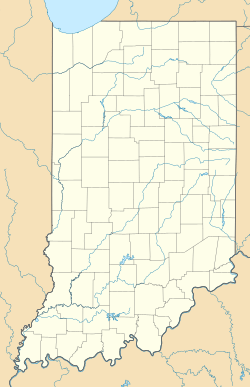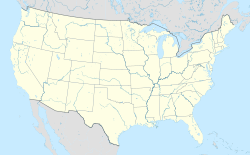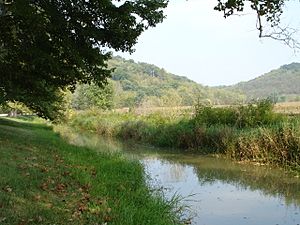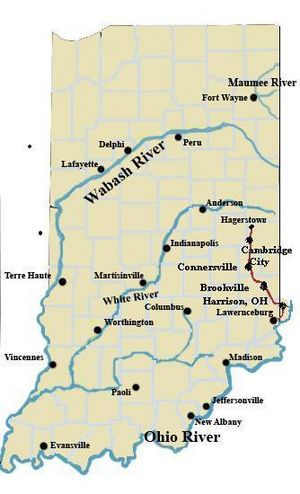Whitewater Canal facts for kids
Quick facts for kids |
|
|
Whitewater Canal Historic District
|
|
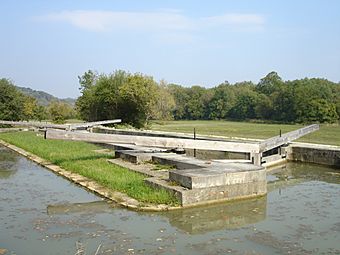
Gordons Lock, September 2007
|
|
| Location | From Laurel Feeder Dam to Brookville, Laurel Township, Metamora Township, Franklin County, Indiana, and Metamora, Indiana |
|---|---|
| Area | 234 acres (95 ha) |
| Built | 1836 |
| NRHP reference No. | 73000272 |
| Added to NRHP | June 13, 1973 |
The Whitewater Canal was an important waterway built a long time ago in Indiana, United States. It was constructed between 1836 and 1847. This canal stretched for about 76 miles (122 kilometers). It connected Lawrenceburg, Indiana on the Ohio River to Hagerstown, Indiana, which is near the West Fork of the White River.
Contents
Discovering the Whitewater Canal
Why Canals Were Important
In the early 1800s, people needed better ways to move goods. Canals were like man-made rivers that helped transport things faster. After the Erie Canal opened in 1825, it showed everyone how successful canals could be. It made a lot of money and changed how people traveled and traded.
Farmers in the Whitewater Valley faced a big problem. They had to take their crops and animals to Cincinnati, Ohio on bumpy, muddy roads. This trip could take several days. A canal would offer a much quicker and smoother way to travel.
In 1836, the Indiana State Legislature passed a law called the Indiana Mammoth Improvement Act. This law allowed for the building of the Whitewater Canal and many other improvements across Indiana.
Building the Whitewater Canal
The plan for the Whitewater Canal came from a survey done in 1834. It was designed to be 76 miles (122 km) long. The canal would start near Hagerstown and follow the river valley. It would pass through towns like Connersville, Brookville, and Harrison, Ohio, before ending in Lawrenceburg, Indiana.
Challenges During Construction
Building this canal was a huge challenge! Over its 76 miles, the canal dropped 491 feet (150 meters) in elevation. This was a very steep path for a canal. Because of this steepness, engineers had to build 56 locks and seven dams. Locks are like water elevators that help boats move up or down different water levels.
Construction began on September 13, 1836. The first boat reached Brookville from Lawrenceburg on June 8, 1839. However, the state of Indiana ran into money problems. Building stopped in August 1839 and didn't start again until 1842.
In 1842, the state gave control of the canal to a private company. This was the White Water Valley Canal Company. They promised to finish the canal to Cambridge City within five years. By 1843, boats were reaching Laurel. By 1845, the canal was working all the way to Connersville. The company borrowed money to finish the last section to Cambridge City. The final part, from Cambridge City to Hagerstown, was built by the Hagerstown Canal Company and finished in 1847.
The Canal's Short Life
The Whitewater Canal was used for only a short time, but it made a big difference to the towns it served. The state had set aside a lot of money, $1,400,000, for the canal. This was a huge amount back then! However, the big improvement plan of 1836 put a lot of stress on Indiana's finances. The state ran out of money in the summer of 1839, which stopped construction.
In November 1847, a big flood hit the Whitewater Valley. Many parts of the canal were washed away. The section between Harrison and Lawrenceburg was never rebuilt. This meant the canal stopped working in Lawrenceburg after only eight years. It was just a few months after the canal was fully finished to Hagerstown. It took ten months for the canal to work again north of Harrison. The cost of fixing the flood damage caused serious money problems for the canal for the rest of its active years.
Companies That Helped
The White Water Valley Canal Company
This company was formed after the state of Indiana could no longer afford to finish the canal. They took over the project in 1842. The White Water Valley Canal Company completed the canal through Cambridge City, Indiana. They also built the Canal House in Connersville in 1842. This building is now a historic landmark.
The Hagerstown Canal Company
Hagerstown was supposed to be the very end of the Whitewater Canal. But when the state ran out of money, Hagerstown had to pay for its own canal. The Hagerstown Canal Company built an eight-mile (13 km) long canal. It connected Hagerstown to Cambridge City and was finished in 1847.
The Cincinnati and Whitewater Canal
Another canal was built to connect to Cincinnati. This was called the Cincinnati and Whitewater Canal. It was built by people in Ohio and went from Harrison to Cincinnati. It opened in 1843. After the 1847 flood, this canal became the new end point, replacing Lawrenceburg. This part of the canal closed in 1862. Its path was later used for a railroad. You can still see a tunnel that was part of this canal near Cleves, though it's mostly filled with dirt.
The Whitewater Canal Today
Not much of the original Whitewater Canal is left today. Some of its old towpath (the path next to the canal where horses pulled boats) is now used by the Whitewater Valley Railroad. This railroad still operates as a fun tourist train between Connersville, Indiana and Metamora, Indiana.
You can still see the remains of many canal locks along this section. There's also a diversion dam near Laurel, Indiana. This dam was rebuilt in the 1940s. It provides water for a restored part of the canal in Metamora, as well as for a working mill. This shows that canals weren't just for transportation. They also provided water power for mills and even generated electricity in the early 1900s!
The most famous part of the Whitewater Canal today is in Metamora. This section, from the Laurel Feeder Dam to Brookville, was added to the National Register of Historic Places in 1973. It's known as the Whitewater Canal Historic District. Here, you can experience what the Canal Era was like. There are museums, shops, restaurants, and you can even take a ride on a horse-drawn boat on the canal!
A Special Landmark
An aqueduct is like a bridge that carries water. The canal crosses over Duck Creek at Metamora using an aqueduct. The original wooden aqueduct was built in 1846 but was washed away by a flood. The one you see today is a reconstruction from the 1900s. In 1992, the American Society of Civil Engineers (ASCE) recognized it as a National Historic Civil Engineering Landmark.
Towns Along the Canal
Here are some of the towns that were connected by the Whitewater Canal:
- Cincinnati, Ohio - (through a connecting canal and the Ohio River)
- Harrison, Ohio
- Lawrenceburg, Indiana
- Brookville, Indiana
- Metamora, Indiana
- Laurel, Indiana
- Connersville, Indiana
- Milton, Indiana
- Cambridge City, Indiana
- Hagerstown, Indiana
Gallery
See Also
- Canal
- List of canals in the United States
- List of State Historic Sites in Indiana
- Whitewater Valley Railroad
- Wabash and Erie Canal
- Indiana Central Canal
- Indiana Mammoth Improvement Act


